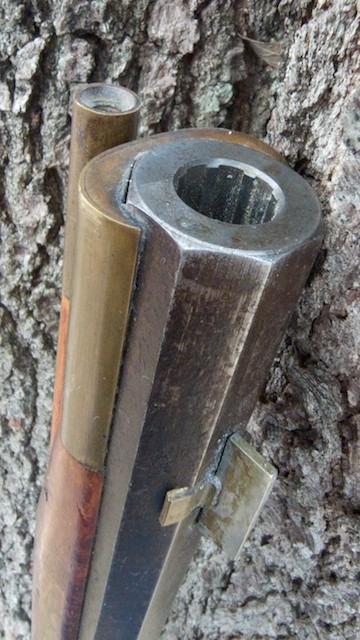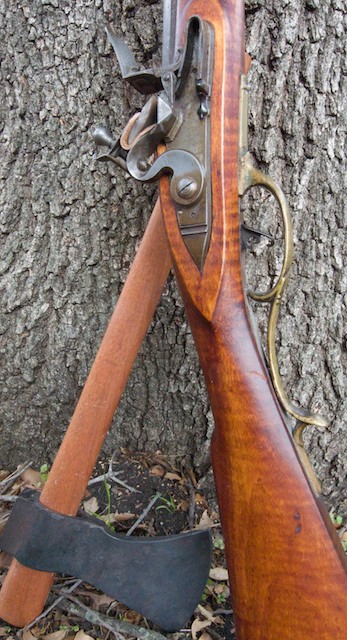What the Framers of the U.S. Constitution Knew About Assault Rifles
Pennsylvania Longrifles served as terrible assault weapons during the American Revolution, said the British.
by Bob Kerstetter
“An Unfair Way of Carrying On a War”
 Privately owned by colonial frontier riflemen, the Pennsylvania Longrifle far surpassed the range, accuracy and killing power of the muskets used by the standing military of the newly formed United States.
Privately owned by colonial frontier riflemen, the Pennsylvania Longrifle far surpassed the range, accuracy and killing power of the muskets used by the standing military of the newly formed United States.
Pennsylvania Longrifles served as the personal assault weapons of the American Revolution. We know this because of historical records of the times, including the writings left by British enlisted men, officers and publications. Some viewed the rifles as immoral. Others glorified the skills of the riflemen. All respected the killing power of the “cursed twisted guns”.
The longrifles used by common American sharpshooters terrorized the British. “Their guns are rifled,” reported Gentlemen's Magazine in 1775, “and they fight in ambush. Five hundred provincials would stop the march of five thousand regulars.” A British regular, William Carter, called the rifles, “…an unfair method of carrying on a war.” In his memoir written after the war, a captain of the British army confessed, “These Americans had riflemen - they could hit a man anywhere they liked at two hundred paces distance. We came to dread them far more than the regular Continentals.” The American riflemen assaulted the British way of war.
Fighting With Muskets in Ranks and Files
The regular British and Continental Armies fought their battles in European style. Facing each other across open fields, the opponents stood in rows and columns, commonly called ranks and files. Upon orders from their officers, the front ranks of each army fired in unison at their enemies. Those in front then moved to the rear in an orderly manner to reload while the next rank advanced to fire. This cycle repeated itself multiple times with each rank moving to the front and firing before retreating, reloading and heading toward the front again. This continuous flow of freshly loaded weapons created massive rapid fire from hundreds of single-shot, muzzleloading muskets. Yet, at the end of each scatter-gun style volley, most soldiers on both sides remained standing unharmed.
Notoriously inaccurate, even the best 18th Century military musket could miss its target by three or more feet at 100 yards. The root of this fault resided in the smooth insides of musket barrels and the imprecise fits of bullets. Military planners wanted quick loading and rapid firing weapons for their regulars. As a result, a British or Continental soldier could reload and shoot every 15 seconds. The smooth barrel and loose fit enabled fast firing. While four shots a minute sounds pretty meager compared to military weapons today, this firepower mushroomed when multiple ranks containing 50 or more muskets fired in rapid sequence. Using muskets to amass firepower made war an inaccurate community effort. Individual marksmanship mattered little if at all.
Fatal Accuracy Against British Officers
American riflemen brought fatal accuracy to the battlefield. Where regulars fought as units, riflemen almost always operated singularly. Even when they moved in groups, these sharpshooters independently targeted specific quarries. Their longrifles could kill humans and animals at up to 400 yards. They could kill consistently with shots to the head at 250 yards. This accuracy resulted from precision weapons in skilled hands. The bullets fit snuggly into the barrels of the longrifles. Grooves inside the barrels slightly rotated the bullets when fired. Spinning the bullets made them fly steadily toward their targets. On orders of their superiors, rifleman snipers frequently targeted British officers.
The shooting of officers worked against the British way of war. Officers serving the Crown held almost sacred roles. British military officers often gained their positions by status or purchase rather than by merit. They typically originated from affluent families or from families seeking upward mobility. War frequently served as a means for building fortunes and elevating social standings. Best of all, being an officer meant relative safety in war. British military protocol forbade the targeting of officers. They expected their enemies to conform to this rule. The Americans punctuated their alternative viewpoint by using the riflemen to specifically target officers and high-ranking regulars. The American goal? Create chaos among the troops. So what effect did this bring to the war?
Poor Against Bayonets, Skilled as Snipers
 Early in the Revolution, riflemen did poorly in open battlefields because they feared British bayonets. Most riflemen carried into battle their rifles and tomahawks, neither provided a match for close-encounters with the bayonets. The British regulars relished their bayonet charges which followed several volleys of inaccurate musket fire. Sometimes the British intentionally fired above the heads of their enemies so more would survive for bayonetting. British officers encouraged bayonetting riflemen without offering quarter to those wanting to surrender. As a result, the riflemen often turned and ran from bayonet charges.
Early in the Revolution, riflemen did poorly in open battlefields because they feared British bayonets. Most riflemen carried into battle their rifles and tomahawks, neither provided a match for close-encounters with the bayonets. The British regulars relished their bayonet charges which followed several volleys of inaccurate musket fire. Sometimes the British intentionally fired above the heads of their enemies so more would survive for bayonetting. British officers encouraged bayonetting riflemen without offering quarter to those wanting to surrender. As a result, the riflemen often turned and ran from bayonet charges.
By 1777, the riflemen fought as decoys, raiders and snipers. In most engagements, they moved along the edges of the battlefields. They covered themselves behind rocks. They climbed trees. Shooting from hiding places, they targeted officers and other key personnel. When the last confrontations of the war ended in 1782 at Fort Henry in West Virginia, on Lookout Mountain in Tennessee and in Chillicothe, Ohio, the riflemen could look back on 149 battles where they helped gain victories. When they fought alongside the regular Continentals, the riflemen helped win 63% of the battles. When they fought alone, the riflemen won 74% of the time.
Trusting “We the People” with Deadly Rifles
After the end of the war, the riflemen headed home. Many lived on the edges of society, preferring seclusion away from population centers. Some returned to their American Indian wives and children beyond the western frontier. The rifles they had carried into battle belonged to them. These also journeyed home. Most of these men lived in peace. The rifles brought them food and fun. When necessary the riflemen would fight. Their Pennsylvania Longrifles far surpassed the range, accuracy and killing power of the muskets used by the small standing military of the United States.
While not all leaders of the new country appreciated the riflemen—many viewed them as vulgar and impolite—the framers of the U.S. Constitution saw value in trusting an armed population. Because the framers had participated in the American Revolutionary War, they also understood the deadly potential of Pennsylvania Longrifles. Despite this knowledge, they added the Second Amendment to the Bill of Rights. They made individual citizens better armed than the federal military.
The Work of Exceptional Minds
Of course the framers of the Constitution made mistakes—the most painful one being the protection of slavery. Other than this tragic error, the Constitution was and still is the work of exceptional minds. It outlaws aristocracy. It checks and balances power. It intentionally slows the speed of change to protect “We the People” against the universal, perpetual and corrupting influence of absolute power and emotional majorities.
Because of their experiences with Pennsylvania Longrifles, the framers of the U.S. Constitution clearly understood the power and potential abuses of superior weapons in civilian hands. The framers included the Second Amendment as one of several essential protections against the forces of tyranny. Along with the guarantees of press and religious freedoms in the First Amendment, the Second Amendment helps secure the rights of everyday people. At the same time it creates risks of abuse by firearms in the possession of unstable, selfish or thoughtless individuals.
--
About the Author. Bob Kerstetter researches and shoots Pennsylvania Longrifles, including building an unadorned replica of a 1770-era weapon. He also does one-person presentations as General Daniel Morgan, one of the leaders of the riflemen during the American Revolutionary War. He tries to write historically accurate articles and seeks to improve by listening to others. You can follow him as Village Hiker on Twitter and Facebook.
--
To learn more about the Pennsylvania Longrifle — also known as the Kentucky Longrifle — see the The Frontier Rifleman, an excellent secondary resource by Richard B. LaCrosse, Jr. You may be able to find this book in your local library or through Inter Library Loan. You can also purchase the Frontier Rifleman from Amazon
.
For instructions on how to build a longrifle, see Recreating the American Longrifle by William Buchele, George Shumway and Peter A. Alexander. This is the book used by the author of this article to learn how to build a Pennsylvania Longrifle. Building a rifle is difficult but worth the effort. Even if you choose not to build a rifle, the education provided by this book is excellent. You may be able to find this book in your local library or through Inter Library Loan. You can also purchase Recreating the American Longrifle from Amazon
.